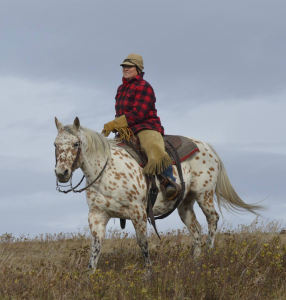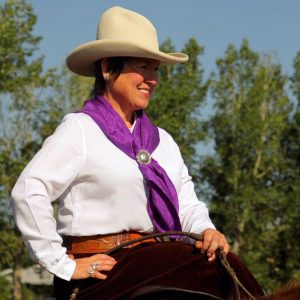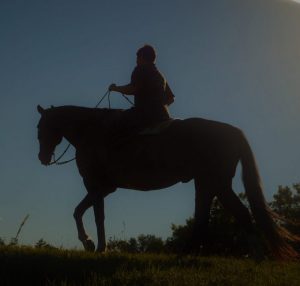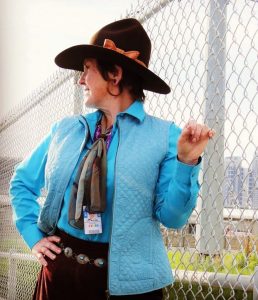
Lee McLean
This week, we hear from occasional guest columnist, Lee McLean, a horsewoman and writer in Alberta, Canada.
She runs Keystone Equine and has an impressive Facebook following.
Here, McLean writes about Riding As We Age. Excellent pointers here!
McLean writes:
Whether we’re getting older, recovering from illness, or returning from a long time out of the saddle, there may be one or two points here that can help:
1. Avoid getting hurt! Eleanor Roosevelt famously said, “Do one thing every day that scares you.” Good advice, but I don’t think she was talking about riding. As we age, a suitable horse is often a high-mileage senior. More and more, I’m drawn to the smaller horse, even a good pony.
I know of one senior who traded her incredibly talented sport horse straight across to a keen, deserving but financially-strapped junior who had outgrown her trusty large pony. A smooth mover is preferred and one that does not pull, buck, or shy is essential. Maintenance issues to keep an old horse going are generally worth the cost and effort.

PC: Shannon Lawlor
2. Get fit. Not ‘teeny-tiny jeans’ fit, but strong, healthy, and as lean as you can make it. Start working out, both in flexibility, walking, and your core’s strength. Pay attention to hip flexors. I try and walk a lot and have joined an excellent online yoga group, Dressage Rider Training, geared specifically for riders. It also helps my mindset, my posture, and my breathing.
Getting enough sleep is key as we age, as it makes a difference to our pain and reactions. I find that if I pay attention to my body from a health and riding point of view, it’s easier to make a change in my lifestyle.
3. Choose comfy clothing. This runs the gamut from boots that will allow my foot to slip out of the stirrup to comfortable, seamless underwear and correct bras for riding. A helmet may bring you peace of mind, even if you’ve gone decades without.
I’m a western rider but I ride only in jeans made for the purpose, Kimes Ranch Jeans, Wrangler, or Levi’s, for example. The seams lie flat and they never ride up at the knee. Purpose-made riding clothes are usually worth the extra money.
 4. Tack: My saddle must be narrow enough through the twist (the part of the saddle near the seat bones) to suit me. My stirrups must be turned to not aggravate my high-mileage knees. My saddle must allow for somewhat more angulation of my hip, knee, and ankle to cushion my ride. This might involve shortening the stirrups or riding an older dressage saddle without the thigh blocks that force a vertical leg.
4. Tack: My saddle must be narrow enough through the twist (the part of the saddle near the seat bones) to suit me. My stirrups must be turned to not aggravate my high-mileage knees. My saddle must allow for somewhat more angulation of my hip, knee, and ankle to cushion my ride. This might involve shortening the stirrups or riding an older dressage saddle without the thigh blocks that force a vertical leg.
Many people start wanting to ride a lighter saddle. When the average stock saddle can be 35 pounds or so, smaller skirts and a lighter tree can make a difference.
5. Use a mounting block, every single time, for both getting on and getting off. Trust me, your horse will learn to love it.
6. Learn your triggers. I’m learning to listen to my body. I pay attention to what things cause me pain and discomfort. I’ve learned that if I avoid orange juice, for example, my wrists and knuckles will be free of pain. This one thing allows me to comfortably hold my reins!
We all have our little triggers and we get very good at blocking out their message. These include flours and sugars, things I’m now avoiding. Sorry, folks, but that daily dose of wine is another one to limit.
7. Talk with your doctor. He or she will want to know your activity level and may have ideas about meds or exercises to enhance your riding experience. If hip and knee replacements are on your radar, then bite the bullet and get in line to have them done. I’ve seen so many friends quit riding but then land back in the saddle again after receiving bionic joints.
 If you need a hearing aid to hear the riding instructor or the caller in the dressage test, look into it. Hearing well makes a huge difference to your mood and to your safety. If you’re feeling dizzy and dealing with vertigo, there are meds and exercises that can lessen this. Ditto, incontinence. Go talk to the doc.
If you need a hearing aid to hear the riding instructor or the caller in the dressage test, look into it. Hearing well makes a huge difference to your mood and to your safety. If you’re feeling dizzy and dealing with vertigo, there are meds and exercises that can lessen this. Ditto, incontinence. Go talk to the doc.
8. Eat on schedule. Hydrate. Don’t allow yourself to go into low blood sugar. It’s not safe for you and your panicked or compromised energy can affect your horse. That means keeping healthy snacks on hand, usually something simple with protein – a boiled egg, a slice of meat, a piece of cheese – along with lots of water.
This also means emptying your bladder before you ride, even part way through if you’re in a vigorous lesson. Please don’t be ashamed about leakage. It’s a fact of life as we age, particularly for women. You are not alone. So many accomplished horsewomen are dry in the saddle thanks to their Depends.
9. Find your tribe. While riding alone is lovely, riding with like-minded souls is good for you. A group of riders of a certain age is comforting, they understand you. But remember that riding with younger people will also pull you out of your comfort zone. I believe that shared laughter truly is the best medicine.
Understand that our memory can be affected as we age. This can make remembering tests a challenge, particularly during the stress of competition. If this is you, don’t panic. Find out to what level you can have your tests called and then, make use of the help.
Now is the time to volunteer, if you can. It will boost your mood to share your expertise and love of horses with others. This can be in the office at the next horse show, running the online study group and quizzes at local Pony Club, judging 4H, speaking online to helping at therapeutic riding, or planning to read favorite horse stories aloud to elementary school children, when next we can gather together. It feels good to be needed.
10. Keep riding! We lose our nerve and flexibility very quickly if we cut back on our riding time. This can be hard in the winter months. The trick is to get up there as often as we can and keep riding a regular part of life.
In parting, I’d say adapt your horsemanship, to the point of learning a new sport. This is such a boon to keeping our enthusiasm high. We all think we’ll get into carriage driving when we no longer can ride… but our safety in doing so is wholly dependent on finding—or creating—a bombproof driving horse or pony. For those with hip pain, have you tried riding sidesaddle?
Whatever your sport, the trick is in finding a teacher who understands and challenges you, all the same.
One of my older and very inspirational riding friends tells herself that whenever she feels ‘too old to do something’, she has only to do it one more time, to prove herself wrong.
Thank you for this wonderful article. Excellent tips and insight which I have not seen anywhere else!
Great inspiration and motivation as I enter a new decade and inevitable phase of my life-long passion for horses. I expect there are many like me that did not realize their childhood dreams of having a horse until later in life. We have a shorter runway than some but still a long way to go when we acknowledge our limitations.
Such good advise!…I don’t think she left anything out! Thanks for the inspiration. Anyone who is riding and learning with Lee is lucky!
Happy to continue the adventure with these points in mind. It is often hard for us to remember all the ways we can help ourselves on the journey with our horses.
At 65, now 66 yr old , I enrolled in an online rider fitness course! I was in my prime, 29-31, a long distance runner! Until a MD told me no more! My SI joints were bone on bone🤨 – that was back in my mid-30s! I returned to horseback riding at age 57! No one will ever stop me from riding my horses! Over the past year my body has regained it’s flexibility, strength, coordination and I have regained my confidence!!❤💞🤸♀️🙆♀️. I went from having 1 horse to 3! Next spring will be 4! My mare is pregnant 😁🙆♀️. I am living my dream 💞💞💞💖🐎🐎🐎🐎
P.S. my KMSH, does drive: I have a gorgeous refurbished 1880s carriage and a 2 wheel cart I’m refurbishing this summer.
Great article. Sometimes us oldies are left out as being past it.!!At 73 and with 2 slipped vertebrae, granted grade 1 slippage, I ride, arena and trail, dressage has become a passion too as found such joy being able to do lateral movements. A little trot and even less canter but that,s ok. walk is great and you can learn plenty. Just bought what will be my last horse I think. He is a solid PRE 15 years old. My partner of 26 years has a fetlock problem so can’t expect her to carry me although we still do ground work together to keep her fit and feel worthy and loved . My horses sidle up to the wall for saddling. Yes I have a light weight English saddle which I can put on alone for riding in arena and around farm and a heavier Western one which I need help with to put on when I Trail ride . So yes, stay in the saddle as good for the body and the mind and if that,s not possible just being with your best friends your horses and grooming, taking them for walks, playing games or just hanging out reading a book in the meadow with them is such a joy. So getting old is never a problem.